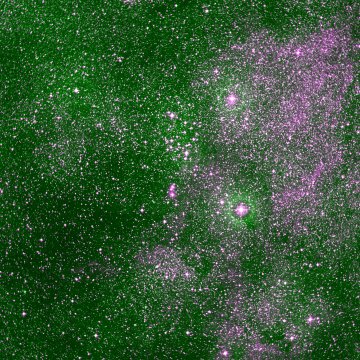Gum 57b
Also called
RCW 119, Sh 2-2Coordinates: (347.7°, 1.9°)
[ Catalog | Explorer | SIMBAD ]
HD 153919 is a runaway star ejected from the Sco OB1 star association in a supernova explosion about 2 million years ago.
The bubble surrounding HD 153919 is discussed by Benaglia and Cappa. [1]
HD 153919 is a runaway star ejected from the Sco OB1 association in a supernova explosion about 2 million years ago.[2]
Avedisova lists a second ionising star for RCW 119 (the O9 II-III class HD 153426). SIMBAD says that this is associated with the separate HII region Gum 57a.
A 2004 paper concludes that HD 153426 is part of an uncatalogued star cluster at distance of 2100 parsecs.[3]
The RCW catalog uses RCW 119 to designate the entire emission region surrounding HD 153919 and RCW 119a for the enhanced emission seen in the direction of HD 153426. Similarly, Gum uses Gum 57a to designate the enhanced emission and Gum 57b to designate the full HD 153919 emission region.
The Piskunov et.al. cluster catalog gives a distance of 494 pc and an age of about 350 million years for NGC 6281. [4] This would place this cluster between the Orion spur and the Sagittarius arm. It is common to find older clusters outside the major spiral structures as over hundreds of millions of years they can drift from their birthplaces.
SIMBAD lists the hottest star in NGC 6281 as B8 so there can't be much ionising caused directly by the cluster. Most of this must be from hotter background stars.
Notes
1. ^ Benaglia, P. & Cappa, C. E. (1999). "Possible wind blown bubbles associated with five Of stars", Astronomy and Astrophysics, Vol. 346, 979-989. [1999A&A...346..979B]
2. ^ Ankay, A., Kaper, L., de Bruijne, J. H. J., et al. (2001). "The origin of the runaway high-mass X-ray binary HD 153919/4U1700-37", Astronomy and Astrophysics, Vol. 370, 170-175. [2001A&A...370..170A]
3. ^ de Wit, W. J., Testi, L., Palla, F., et al. (2004). "The origin of massive O-type field stars. I. A search for clusters", Astronomy and Astrophysics, Vol. 425, 937-948. [2004A&A...425..937D]
4. ^ Piskunov, A. E., Schilbach, E., Kharchenko, N. V., et al. (2008). "Tidal radii and masses of open clusters", Astronomy and Astrophysics, Vol. 477, 165-172. [2008A&A...477..165P]
Links
[ DSS | ADS | ADS Abstract ]
map | book | blog | gallery | sources

This image was created using the POSS-II/UKSTU data of the Digitized Sky Survey and SuperCOSMOS using the process described here.
According to my correspondence with the Royal Observatory Edinburgh and the Space Telescope Science Institute, I am allowed to use the POSS-II/UKSTU data to create and display images for non-commercial purposes so long as I include this fine print for the SuperCOSMOS data:
Use of these images is courtesy of the UK Schmidt Telescope (copyright in which is owned by the Particle Physics and Astronomy Research Council of the UK and the Anglo-Australian Telescope Board) and the Southern Sky Survey as created by the SuperCOSMOS measuring machine and are reproduced here with permission from the Royal Observatory Edinburgh.
and this acknowledgement taken from the DSS site:
The Digitized Sky Surveys were produced at the Space Telescope Science Institute under U.S. Government grant NAG W-2166. The images of these surveys are based on photographic data obtained using the Oschin Schmidt Telescope on Palomar Mountain and the UK Schmidt Telescope. The plates were processed into the present compressed digital form with the permission of these institutions.
The Second Palomar Observatory Sky Survey (POSS-II) was made by the California Institute of Technology with funds from the National Science Foundation, the National Geographic Society, the Sloan Foundation, the Samuel Oschin Foundation, and the Eastman Kodak Corporation.
The UK Schmidt Telescope was operated by the Royal Observatory Edinburgh, with funding from the UK Science and Engineering Research Council (later the UK Particle Physics and Astronomy Research Council), until 1988 June, and thereafter by the Anglo-Australian Observatory. The blue plates of the southern Sky Atlas and its Equatorial Extension (together known as the SERC-J), as well as the Equatorial Red (ER), and the Second Epoch [red] Survey (SES) were all taken with the UK Schmidt.
The "Second Epoch Survey" of the southern sky was made by the Anglo-Australian Observatory (AAO) with the UK Schmidt Telescope. Plates from this survey have been digitized and compressed by the ST ScI. The digitized images are copyright ? 1993-5 by the Anglo-Australian Observatory Board, and are distributed herein by agreement.
The "Equatorial Red Atlas" of the southern sky was made with the UK Schmidt Telescope. Plates from this survey have been digitized and compressed by the ST ScI. The digitized images are copyright ? 1992-5, jointly by the UK SERC/PPARC (Particle Physics and Astronomy Research Council, formerly Science and Engineering Research Council) and the Anglo-Australian Telescope Board, and are distributed herein by agreement.
The compressed files of the "Palomar Observatory - Space Telescope Science Institute Digital Sky Survey" of the northern sky, based on scans of the Second Palomar Sky Survey are copyright ? 1993-1995 by the California Institute of Technology and are distributed herein by agreement. The compressed files of the "Palomar Observatory - Space Telescope Science Institute Digital Sky Survey" of the northern sky, based on scans of the Second Palomar Sky Survey are copyright ? 1993-1995 by the California Institute of Technology and are distributed herein by agreement.